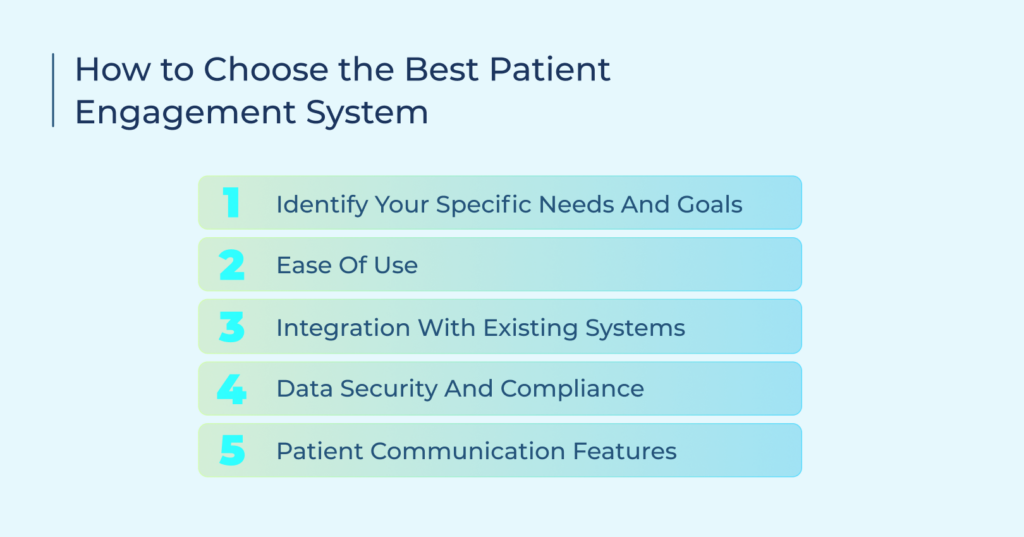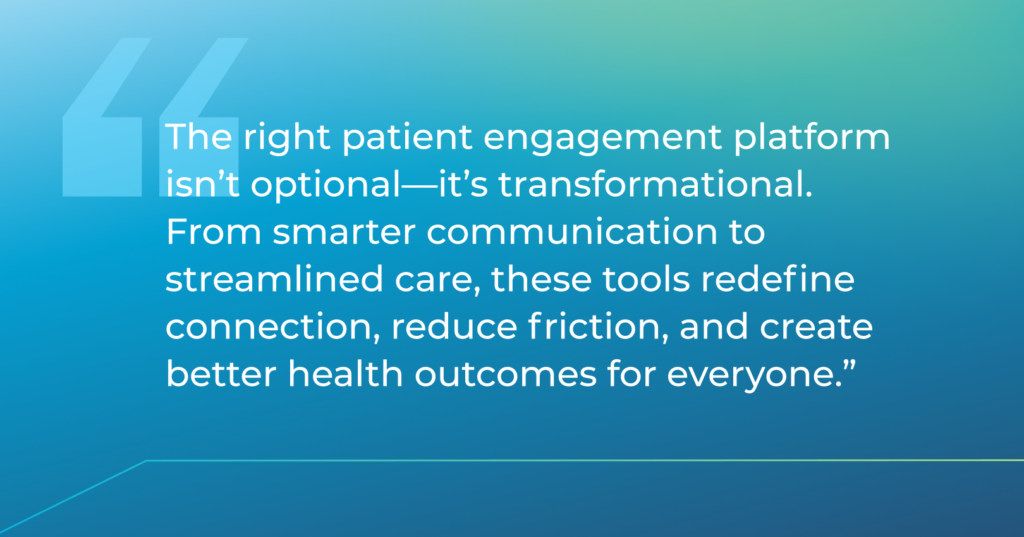Small healthcare practices often face challenges when it comes to maintaining strong, consistent communication with…

Best Patient Engagement Software for Healthcare Providers in 2025
Healthcare organizations continue to embrace digital technologies to integrate smart tools and solutions that improve their care capabilities beyond just managing appointments.
Patient engagement software and platforms are now fundamental to running any modern medical practice. The right fit can improve your communications, reduce administrative burden, and enhance the overall patient experience.
Choosing from the top patient engagement providers can significantly help you build stronger relationships with your patients while keeping operations efficient and future-ready. However, it’s not as simple as finding a random vendor. Take your pick from the best patient engagement software listed below.
1. Televox
TeleVox provides a comprehensive patient engagement platform for healthcare enterprises. Its AI-driven solutions are designed to drive meaningful patient relationships through the magic of next-generation automation.
What makes TeleVox different from other AI-powered care providers is its advanced SMART Agent technology. The platform deploys virtual agents that can handle actual two-way human conversations through conversational AI. Patients can respond, ask questions, and complete tasks like scheduling appointments or making payments within the same conversation.
The platform also offers built-in reporting with live response tracking to help organizations measure effectiveness and adjust strategies on the fly.
Pros:
- Multiple communication channels (text, voice, email, postcards).
- Two-way conversation capabilities.
- Live response tracking.
- Reduces no-show appointments.
- Supports self-service appointment management.
- Multi-language capabilities.
- On-demand broadcast messaging options.
- AI virtual assistant functionality.
- Strong customer support.
Cons:
- Interface is powerful, but may require orientation especially dashboard may involve a brief learning curve during initial setup, but most teams adapt quickly with the help of TeleVox’s onboarding support and training tools.
- Customization is structured, not granular. TeleVox’s modular messaging ensures consistency and compliance, though it may offer less flexibility for highly individualized templates. That said, its formats are optimized for strong patient engagement.
- Phone-based communication may not suit all patients but a SMART SMS feature is built to prioritize text-first engagement where appropriate.
- Integration into existing EHR systems or workflows might take collaboration, especially in large organizations. However, TeleVox provides dedicated support throughout the implementation process to minimize friction.
2. NexHealth
NexHealth is widely used by medical practices, especially dental, that want a text-based digital patient experience. It offers five different solutions that automate and streamline your communication and payment processes.
NexHealth particularly stands out as an excellent patient engagement software because of its robust integration. The platform easily integrates with your existing management system and automatically synchronizes all historical (and new) data in real time without requiring any manual data entry.
Your healthcare organization can also use its outreach tools for targeted campaigns to get more appointments.
Pros:
- Two-way HIPAA-compliant texting.
- Online scheduling that syncs with practice calendars.
- Automated appointment reminders and recall messages.
- Automated feedback requests right after visits.
- Automated insurance eligibility verification.
- Self-serving patient portal with payment processing capabilities.
Cons:
- Appointment reminders sometimes display incorrect times to patients.
- Syncing can take up to 45 minutes to update changes.
- Limited ability to send or receive images in texts.
- Patients who cancel appointments may still receive reminders.
- Integration with certain practice management systems (like Curve) needs improvement.
3. Klara
Klara aims to reduce phone call volumes in favor of a unified platform that supports text messaging, web chat, call-to-text, and voicemail transcription. It is specifically designed for medical practices that use various EHR systems like AdvancedMD and Veradigm.
Considering its stacked features, Klara still manages to offer one of the best user-friendly interfaces among all patient engagement software. Your patients are not required to download any apps, create accounts, or remember passwords. However, the faster communications are still secure and HIPAA-compliant.
Pros:
- Converts phone calls to text messages, reducing staff phone time.
- Works without requiring patients to download apps or create accounts.
- Integrates voicemail transcription to process messages quickly.
- Connects directly with pharmacies and labs to reduce hold times.
Cons:
- Users can’t see the history of mentions if accidentally dismissed.
- Certain patient replies may send them unnecessary notifications.
- Some users report difficulty distinguishing between legitimate messages and spam.
- Text transcription of voicemails isn’t always accurate.
4. Phreesia
Phreesia uses automation to reduce your medical administrative workload, but not at the expense of losing the human touch. This single platform combines several healthcare features such as online scheduling, appointment reminders, payments, and even patient outreach to improve your appointment numbers.
Something that makes Phreesia stand out is that it is specifically built for healthcare providers with high patient volumes but fewer staff members. It easily integrates with existing systems to bridge service gaps and help patients manage their appointments and payments before, during, and after visits.
Pros:
- Supports the complete patient journey, including post-visit follow-ups.
- Automates benefits checks and payment collection, improving billing accuracy.
- Reduces hiring and training expenses by closing staffing gaps.
- Offers tailored workflows by specialty (cardiology, OB/GYN, dermatology, etc.)
Cons:
- Smaller clinics may need help adjusting to the onboarding process.
- The interface can feel cluttered when used without proper training.
- Not every insurance or form field pulls data automatically.
- Some manual steps may remain despite automation features.
5. Solutionreach
Healthcare providers interested in reducing their no-show rates find exceptional results with Solutionreach. This platform features everything you need to drive patient engagement, including automated appointment reminders, patient messaging, online scheduling, and payment processing. Solutionreach is designed with the sole goal of saving your staff from mundane tasks so that they can focus their efforts on patient satisfaction.
Pros:
- Reduces no-shows through automated appointment reminders.
- Offers real-time texting capabilities to gather insurance information and schedule appointments.
- Works for various practice types, including dental, vision, and medical offices.
- Includes batch messaging for efficient mass communications.
- Implementation typically takes less than one week.
Cons:
- Users report inconsistent customer support and response times.
- Some mention reliability issues that impact practice operations.
- Multiple reminders can sometimes annoy patients.
- Location confusion in reminders creates problems for multi-location practices.
- Limited space for detailed support requests.
- Technical issues may take time to resolve.
6. Tebra
Tebra is a powerful engagement software for healthcare providers, especially independent practices and billing companies. It is an all-in-one EHR platform that unifies your operations. While you can find several other platforms that promise the same, what makes Tebra different is that it connects you with over 130 healthcare systems. That includes your electronic health records, revenue cycle management, patient scheduling, prescriptions, billings, and insurance- all accessible from a single interface.
Pros:
- Integrates EHR, billing, and patient management in one platform.
- Connects with over 130 healthcare systems.
- User-friendly interface.
- Helps practices convert physical files to digital records.
- Enables patient self-scheduling and digital intake forms.
- Provides full security and HIPAA compliance.
- Works without contracts or large upfront costs.
Cons:
- System outages can force practices to close temporarily.
- Some billing professionals report problems that affect revenue cycles.
- Medication management features have limitations, especially for controlled substances.
- Patients may find billing statements confusing.
- Customer service quality appears inconsistent.
7. ModMed
ModMed believes a responsible AI makes your healthcare better, and their results prove just that. The platform is specifically designed for healthcare providers and organizations that want more (and better) control over how they interact with their patients. This includes the usual appointment reminders, online forms, billing, etc.
Beyond that, however, are AI-driven solutions to drive patient experience on whole new levels. With automated clinical workflows, documentation, messaging, and even analytics and reporting to monitor your operations, ModMed offers all the tools you need to spend more time on your patients instead of chasing paperwork.
Pros:
- Uses AI to reduce time spent on notes and follow-ups.
- Built for specialty practices with specific workflows.
- Clean interface that makes navigation easy for staff and patients.
- Integration with ModMed’s EHR keeps everything in one system.
Cons:
- Limited use for general practices or large hospitals.
- AI suggestions may need frequent review depending on the specialty.
- Pricing can be high for smaller clinics.
- Technical support can sometimes be slow.
8. Artera
Artera uses a smarter approach to healthcare. Its patient engagement platform integrates AI-driven virtual agents to handle all patient communications through voice and text.
You empower your staff to respond faster and more accurately, gain access to automatic translation, make use of conversation summaries, enhance efficiency with automated workflows, and a whole lot more, thanks to natural language processing.
Artera’s staff-supporting tools and fully autonomous options set itself apart from several other AI solutions in the healthcare market.
Pros:
- Works with all major EHR systems.
- Supports 109 languages.
- Flexible implementation options based on AI readiness.
- Handles both voice and text communications.
- Pre-validated healthcare workflows.
- High customer retention.
Cons:
- Requires investment in digital transformation.
- May need staff training for implementation.
- Multiple solution options might create complexity.
- Healthcare-specific focus limits use in other industries.
- Multilingual capabilities may be prone to errors.
9. DoctorConnect
DoctorConnect brings a comprehensive patient engagement suite of solutions to the table. The platform is designed to be compatible with your existing systems, ensuring quick deployment with minimum disruptions.
DoctorConnect focuses on reducing no-show rates, managing patient scheduling, collecting patient information through digital forms, and automating all communications, including follow-ups, to improve patient engagement at all major touchpoints.
Pros:
- Integrates easily with existing EMR systems.
- Includes telehealth appointment functionality.
- Offers automated no-show management.
- Provides secure messaging options.
- Includes patient satisfaction surveys.
- Built-in patient recall system.
Cons:
- May require staff training for implementation.
- Limited customization options in some features.
- Unclear pricing structure based on available information.
- Return calls display unfamiliar numbers to patients.
10. CipherHealth
CipherHealth aims to help healthcare providers deliver personalized support throughout the patient journey. The platform unifies patient and staff communication to coordinate care across the board, including at-home patients.
Several solutions, such as digital rounding tools and patient outreach capabilities, work to give patients a voice, improving satisfaction scores and reducing readmissions.
Additionally, workflows can be customized with proven scripts for tailored care and just exceptional patient experiences all around.
Pros:
- Reliable system performance.
- Helps prevent hospital readmissions.
- Provides trend analysis and progress tracking.
- Strong technical support and implementation team.
- Allows personalized patient interactions.
- Comprehensive care journey coverage.
Cons:
- Some functions are difficult to find or confusing to navigate.
- Issues with discharged patients remaining on active rosters.
- Occasional routing of calls to inappropriate departments.
- Multiple patients are sometimes assigned to the same room in system.
- Learning curve for certain features
- Interface could be more intuitive.
11. Relatient
Relatient is another patient engagement software that deserves to be on this list. It is one of the best patient outreach solutions for healthcare organizations to improve their appointment numbers and credibility.
Relatient combines self-service portals for self-scheduling, appointment reminders, no-show engagement, feedback loops, and digital check-ins for time saving. Its solutions are also scalable, something enterprises love.
Pros:
- Personalized communication improves patient retention.
- Easy online scheduling tools.
- Automated scheduling and intakes reduce administrative burden.
- Improved communication and better convenience mean high patient satisfaction.
- Built-in secure messaging and communication tools.
Cons:
- Getting help from the technical support team can sometimes be delayed or difficult.
- The campaign functionality seems underwhelming or poorly supported.
- Patients can be spammed with too many reminders.
Differentiating Between a Patient Engagement Software and a Platform
Both patient engagement software and platforms are cut from the same cloth. They use technology to help healthcare providers improve their communications with patients. They also serve a similar purpose of empowering patients to conveniently access healthcare services and manage their needs whenever needed.
The differences lie in their offerings. Patient Engagement Software is a one-size-fits-all solution with a set of fixed features that may work well for smaller medical practices. It’s also quick to deploy. However, limited customization and flexibility make it harder to scale or resolve specific issues through tailored features.
A Patient Engagement Platform, on the other hand, is all about growth and customization. You get a complete platform that can be customized based on what you need and prefer. It’s a modular approach that enables healthcare enterprises to build interconnected experiences across every patient touchpoint, which is not possible with a ready-made software package.
Patient engagement providers can help you navigate these differences and choose the right solution based on your needs.
Why Platforms Win Long-Term
Imagine a healthcare organization that wants to expand its services. It will need its systems to support new features and update existing ones. Having a robust patient platform gives you agility in such a scenario, allowing you to build up as needed without overly expensive solutions.
Software locks you in, and while some software vendors can provide custom solutions, customizing your existing software package can easily disrupt ongoing services.
How to Choose the Best Patient Engagement System

1. Identify Your Specific Needs and Goals
Just because a patient engagement software has dozens of good reviews doesn’t mean it’s the right fit for you. Make a list of what you want or need. Review your current patient experiences and systems or conduct patient surveys to find out what can and should be improved.
Once you have identified areas that are failing to engage patients, research the best patient engagement software that delivers on those fronts. Purchasing highly rated solutions without confirming your requirements is akin to wasting time and money.
2. Ease of Use
You can have all the features in the world, but they won’t matter much if your patient engagement platform is not user-friendly. Remember that the whole idea is to make patient interactions easier and convenient.
Hence, one of the first things to consider when choosing your patient engagement platform is to confirm that it is easy to navigate. The main features should be easy to find. There should be no clutter or confusion in the design.
3. Integration With Existing Systems
Your patient records are extremely important. Whichever patient engagement software or platform you choose, make sure it is perfectly compatible with the existing system. Since most healthcare organizations use EHR and EMR systems, automatically syncing your past digital data ensures no major disruption or loss of data.
4. Data Security and Compliance
HIPAA-compliant systems are absolutely necessary to avoid violations and sanctions. These systems also package security measures to protect your patient data. Healthcare organizations that suffer data breaches lose credibility and trust, making it challenging to engage patients as they should.
5. Patient Communication Features
While these do fall into your requirements and goals, as noted above, some communication features are critical for every healthcare provider. There’s no point in investing in a patient engagement software that does not come with built-in appointment scheduling features or two-way messaging capabilities.
Feedback collection and analytical tools are also equally important. Do not just confirm that a patient engagement platform has these features; evaluate if they actually improve your capabilities to deliver them efficiently.
How to Get Started With Televox
While many platforms offer a wide range of features to engage patients and improve workflows in healthcare, TeleVox stands out as a great alternative for long-term impact.

Getting started takes just a few minutes. Schedule a demo today to see how AI-driven virtual agents can deliver automated care. Our representatives will assess your current workflows to identify opportunities for improvement and develop an implementation plan specific to your organization.



